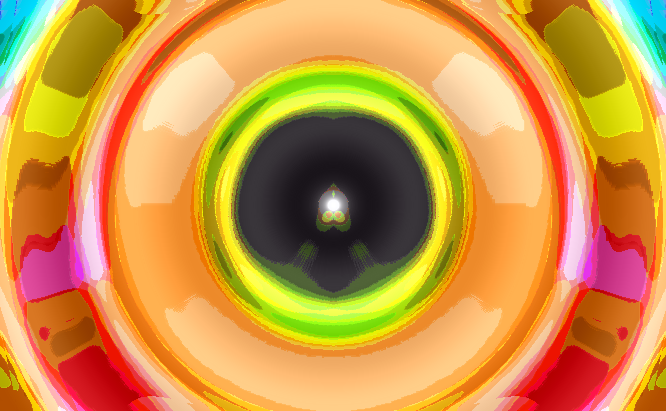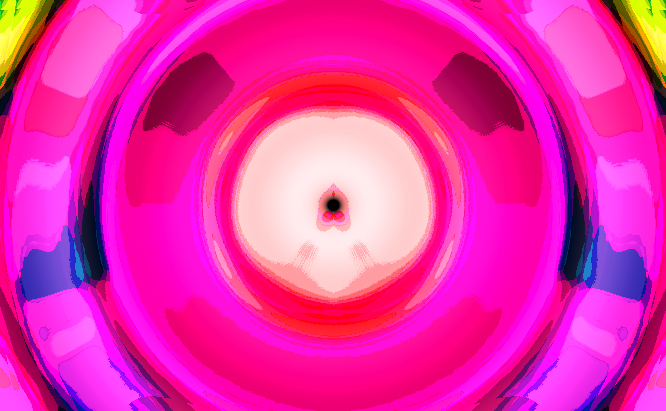o
Mandalas
"Shri Yantra."
Mandala classique illuminé
Le mandala est une représentation symbolique de notre Etre et de l'Univers,
de L'Un au Centre qui S'exprime en son Tout,
de Soi au centre de son Etre et du Tout.
De l'intime au centre de Soi, à l'Universel autour et à l'extérieur de Soi.
Ce model de l'Un qui est Tous, par sa contemplation,
informe intuitivement que le Centre de Soi est aussi Universel
et que par ce Centre comme Un,
chaqu'Un est fondamentalement Un avec le Tout Etre Univers.
O. Aimant D'Amours
Mandala Humain
«Mandala
(Sanskrit: "circle")
in Hindu and Buddhist Tantrism, a symbolic diagram used in the performance of
sacred rites and as an instrument of meditation. The mandala is basically a
representation of the universe, a consecrated area that serves as a receptacle
for the gods and as a collection point for universal forces. Man (the microcosm),
by mentally "entering" the mandala and "proceeding" toward
its centre, is by analogy guided through the cosmic processes of disintegration
and reintegration.»
--from
Encyclopaedia Britannica

L'Humain au Centre de l'Univers
Mandala 203
«In his writings on mandala symbolism, Carl Jung refers to the mandala as "the psychological expression of the totality of the self". (Mandala Symbolism, p.29) Within everyone'psyche, to one degree of another, can be found the seed-center of the self surrounded by a chaotic maelstrom of issues, fears, passions and countelss others psychological elements. It is the very disordered state of these elements that creates the discord and emotional imbalances from which too many of us suffer on a regular basis. The mandala is a template for the mind, a state of peace and order, a resolution to the chaos within. In Jung's words, "The severe pattern imposed by a circular image of this kind compensates the disorder and confusion of the psychic state--namely, through the construction on a central point to which everything is related." (p.4)
This central point is the absolute seat of the self, the anchor for all the extraneous elements of your environment and psyche. I refer to your environment and your psyche as if they were separate entities, but in reality the two are inextricably linked. ...certain patterns and symbolic elements from our mont ancient origins have been enternalized and carried throught the ages, only to be unconsciously externalized in the beauty of the mandala.
It gives the psyche a safe place upon which to stand, a solid foundation upon which it can gather itself to achieve completeness and harmony. Furthermore, the central point is the rererence point for the self to identify with. Jung refers to this pattern as the "archetype of wholeness."(p.4)
This ordering effect on the human psyche is not, Jung stresses, the result of conscious reflection or cultural effort. It is a pre-existing condition of consciousness that such patterns help bring it into focus or return to an earlier, more peaceful state. This is why Jung found the mandala to be present in so many cultures and mythologies spanning the globe as well as the history of Humankind itself. It is an integral part of the collective unconscious that is share by every person that has ever lived. The mandala is an unconscious state in which all opposites come together and are united, where the polar aspects of both cosmos and personality become one. This union of opposites is the very process by which we become whole, through which we find peace.» http://www.mandalazone.com/essay-0302.html
L'Amour du tendre au centre des conditions
«There is undoubtedly a common reference point at which all our seemingly individual consciousnesses are connected, and it is from this realm that the form and effect of the mandala are drawn. The mandala can be conidered a blueprint for the essential structure of our existence, and something about this structure is instantly recognized by the unconscious within us. We perceive the shape, the pattern, the elements within it and their relationship to each other, and within that sacred matrix we recognize our self and our place in the cosmos. It is an ancient and fundamental relationship from which we have strayed. The mandala is the key to recovering it.» http://www.mandalazone.com/essay-0302.html
L'Oeil comme mandala est mirroir de Soi au centre du Tout.
Du point de vue de l'oeil contemplant l'Univers,
celui-ci se voit au Centre de tout ce qui est.
C'est une vérité relative qui est symbolique de la vérité absolu,
que chaque Etre est une manifestation unique de l'Éternel Etre Énergie fondamentale qui Se manifeste en variété d'Autres Unités de Soi-meme.
.O.
«Jung also equates the mandala with the eye in form as well as spirit, stating that "the eye is the prototype for the mandala." (p.52) The eye is the part of us that beholds the univers and sees our place in it. The eye takes in light, the pure energy of the universe, and presents it to the inner spirit. It is the introduction, indeed the union, between the self and the cosmos. » http://www.mandalazone.com/essay-0302.html
Miroir de l'Universel Unité au milieu des variétés.
«The
mandala mirrors this joyous Universal harmony of which we are clearly a part; it
is the very essence of serenity and contentment. It shows us-- or rather reminds
us of-- the essential form of our innermost Self, because it is a reflection of
the Universe as a whole, and thus an image of our own spiritual unity with the
Cosmos.»
http://mandalazone.com/essay-100102.html
« It is evident that the mandala is the link, albeit a mysterious one, between our modern consciousmess and our most ancient origins.
"Their basic motif is the premonition of a center of personality, a kind of central point within the psyche, to which everything is related, by which everything is arranged, and which is itself a source of energy." (p.73)
Somewhere in the vast, forgotten reaches of time lies the answer to this wondrous mystery, but also does it lay, quiet and dormant, deep within each one of us. It is for us to rediscover, and to cherish. It is for us to hold this inexhaustible source of energy close to our hearts. Within it we will find ourselves, as well as each other.»
http://www.mandalazone.com/essay-0302.html

.O.
«I had to abandon the idea of the superordinate
position of the ego. ... I saw that everything, all paths I had been following,
all steps I had taken, were leading back to a single point -- namely, to the
mid-point. It became increasingly plain to me that the mandala is the centre. It
is the exponent of all paths. It is the path to the centre, to individuation.
... I knew that in finding the mandala as an expression of the self I had
attained what was for me the ultimate.» - C. G. Jung

Mandala 205
The "squaring of the circle" is one of the many archetypal motifs
which form the basic patterns of our dreams and fantasies. But it
is distinguished by the fact that it is one of the most important
of them from the functional point of view. Indeed, it could even
be called the archetype of wholeness.
- from Mandalas. C. G. Jung. trans. from Du (Zurich, 1955)